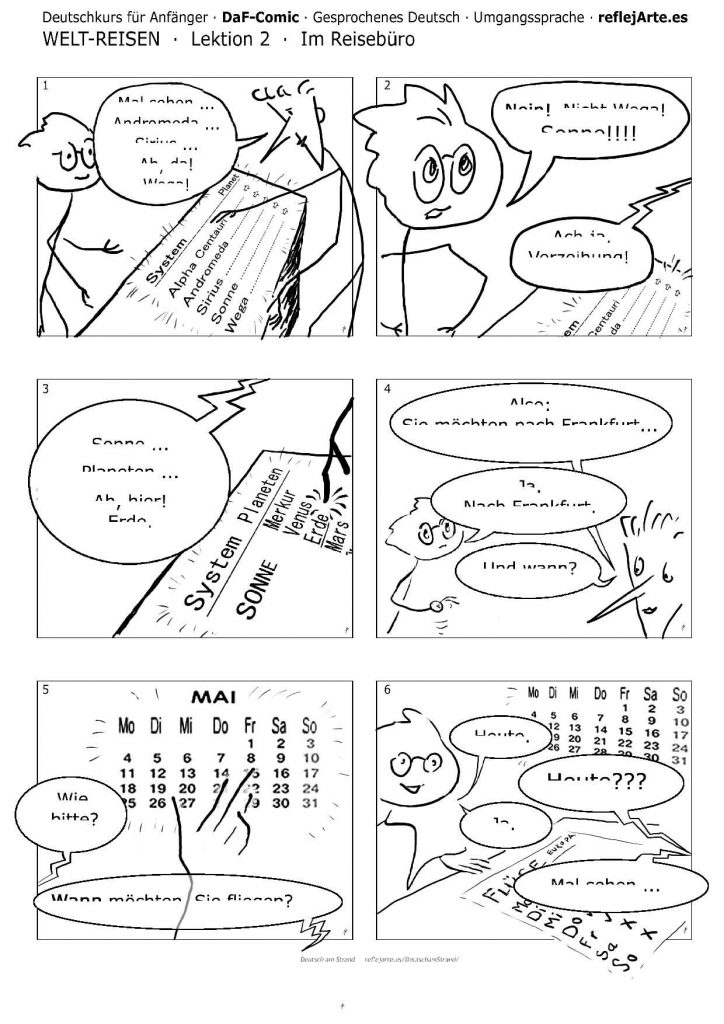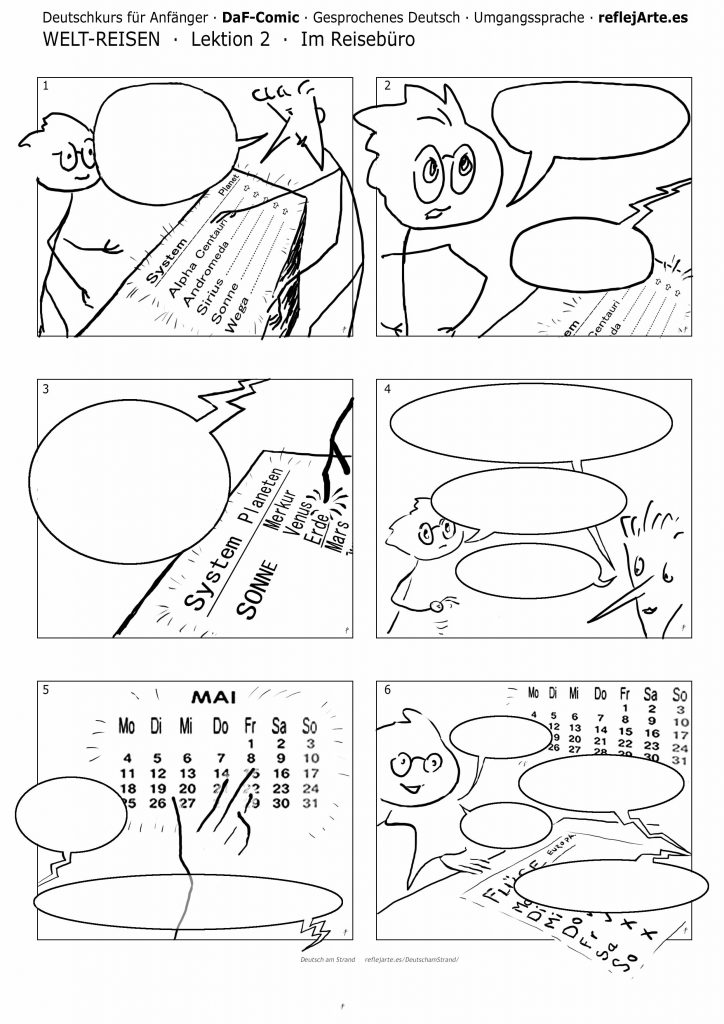Letzte Aktualisierung: 30.09.2023![]()
Lektion 2
Im Reisebüro WELT-REISEN (Teil 2)
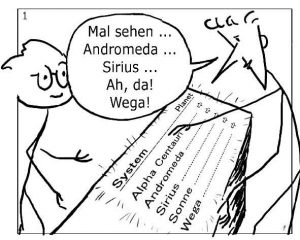
Kommunikationsintentionen:
– Informationen bejahen: ja
– Informationen verneinen: nein, nicht
– Nachfragen: wie bitte?
– Ortsangaben: hier, da
– Konklusion: also
– Zeitpunkt erfragen: wann?
![]() zweisprachiger Comic ·
zweisprachiger Comic · ![]() cómic bilingüe ·
cómic bilingüe · ![]() bilingual comic ·
bilingual comic · ![]() bande dessinée bilingue
bande dessinée bilingue
LEKTION 2
WELT-REISEN
Im Reisebüro (Teil 2)
En la agencia de viajes · At the travel agency · À l’agence de voyages
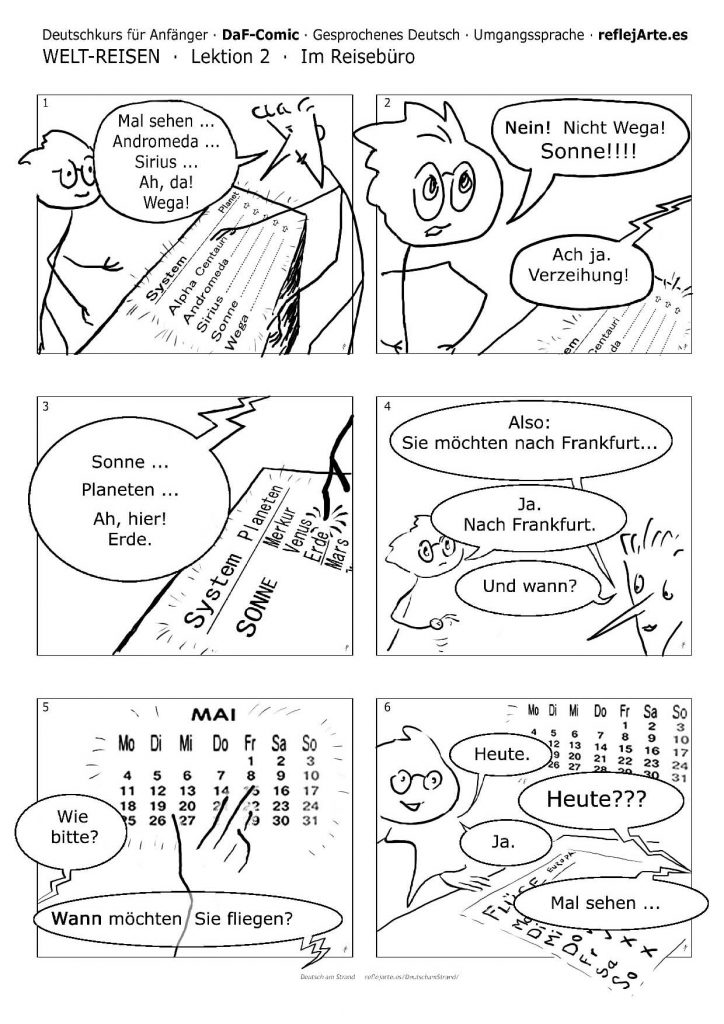
Bild 1 & Audio 1
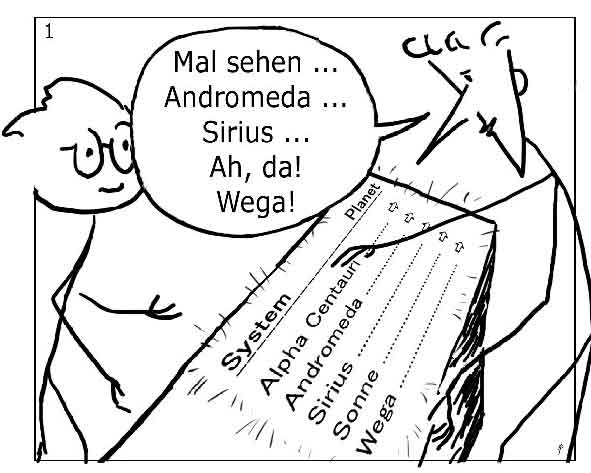
![]() · Mal sehen… Andromeda … Sirius … Ah, da! Wega!
· Mal sehen… Andromeda … Sirius … Ah, da! Wega!
![]() · Veamos… Andrómeda … Sirio … Ah, aquí! Vega!
· Veamos… Andrómeda … Sirio … Ah, aquí! Vega!
![]() · Let’s see… Andromeda … Sirius … Ah, there! Vega!
· Let’s see… Andromeda … Sirius … Ah, there! Vega!
![]() · Voyons… Andromède … Sirius … Ah, voilà! Véga!
· Voyons… Andromède … Sirius … Ah, voilà! Véga!
Bild 2 & Audio 2
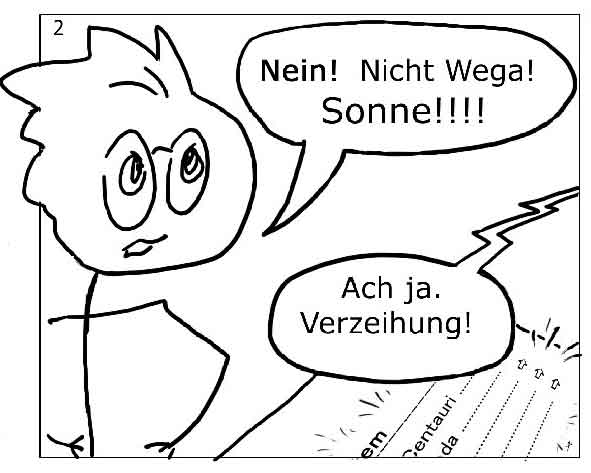
![]() · Nein! Nicht Wega! Sonne!!! – Ach ja. Verzeihung!
· Nein! Nicht Wega! Sonne!!! – Ach ja. Verzeihung!
![]() · ¡No! ¡Vega no! ¡¡¡Sol !!! – Ah, sí. ¡Perdón!
· ¡No! ¡Vega no! ¡¡¡Sol !!! – Ah, sí. ¡Perdón!
![]() · No! Not Vega! Sun!!! – Oh, yes. Sorry!
· No! Not Vega! Sun!!! – Oh, yes. Sorry!
![]() · Non! Pas Véga ! Soleil !!! – Ah oui. Pardon !
· Non! Pas Véga ! Soleil !!! – Ah oui. Pardon !
![]() · Ja = Interjektion zur Bestätigung einer Frage; Nein = Interjektion zur Verneinung einer Frage;
· Ja = Interjektion zur Bestätigung einer Frage; Nein = Interjektion zur Verneinung einer Frage;
nicht ist das Adverb, das bestimmte Satzteile verneint (z.B. einen Namen, das Verb, eine adverbiale Bestimmung, …)
Beispiel: Deutschland ist in Amerika? – Nein. Deutschland ist nicht in Amerika!
![]() · Ja = Sí; Nein = No ;
· Ja = Sí; Nein = No ;
son interyecciones para contestar afirmativa o negativamente a una pregunta.
nicht = no:
es el adverbio que niega determinadas PARTES de la oración (por ejemplo, un nombre propio, el verbo, un complemento circunstancial,…)
ejemplo: Spanien ist in Asien? – Nein. Spanien ist nicht in Asien!
![]() · Ja = Yes; Nein = No ;
· Ja = Yes; Nein = No ;
these are the interjections used to give a short answer, affirmative or negative, to a question.
nicht = no: this is the adverb used to negate some part of a sentence (i.e. a name, the verbe, a complement,…)
example: England ist in Australien? – Nein. England ist nicht in Australien!
![]() · Ja = Oui; Nein = Non ; ce sont les interjections pour donner une brève réponse affirmative ou négative à une question.
· Ja = Oui; Nein = Non ; ce sont les interjections pour donner une brève réponse affirmative ou négative à une question.
nicht = pas: c’est l’adverbe que sert à nier une partie concrète d’une phrase (p.ex. un nom, le verbe, un complément circonstanciel,…)
exemple: Kanada ist in Europa? – Nein. Kanada ist nicht in Europa!
Bild 3 & Audio 3
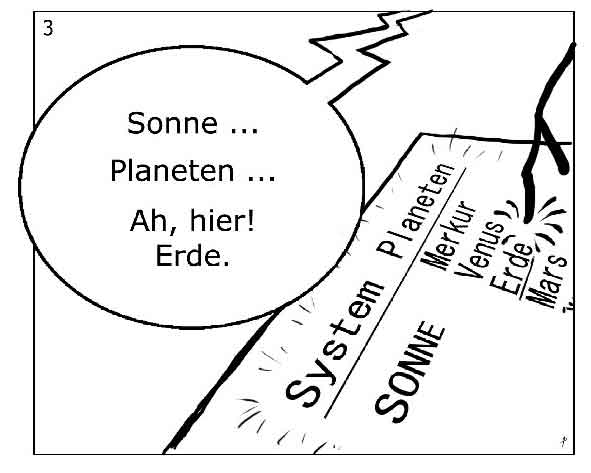
![]() · Sonne … Planeten … Ah, hier! Erde.
· Sonne … Planeten … Ah, hier! Erde.
![]() · Sol … Planetas … Ah, aquí! Tierra.
· Sol … Planetas … Ah, aquí! Tierra.
![]() · Sun … Planets … Ah, here! Earth.
· Sun … Planets … Ah, here! Earth.
![]() · Soleil … Planètes … Ah, voici ! Terre.
· Soleil … Planètes … Ah, voici ! Terre.
Bild 4 & Audio 4
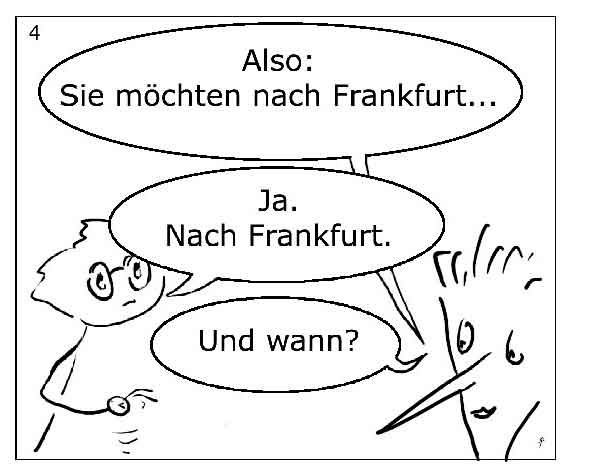
![]() · Also: Sie möchten nach Frankfurt … – Ja. Nach Frankfurt. – Und wann?
· Also: Sie möchten nach Frankfurt … – Ja. Nach Frankfurt. – Und wann?
![]() · Entonces, Ud. quiere (ir) a Frankfurt … – Sí. A Frankfurt. – Y ¿cuándo?
· Entonces, Ud. quiere (ir) a Frankfurt … – Sí. A Frankfurt. – Y ¿cuándo?
![]() · So you want (to go) to Frankfurt … – Yes. To Frankfurt. – And when?
· So you want (to go) to Frankfurt … – Yes. To Frankfurt. – And when?
![]() · Alors, vous voulez (aller) à Frankfurt … – Oui. À Frankfurt. – Et quand?
· Alors, vous voulez (aller) à Frankfurt … – Oui. À Frankfurt. – Et quand?
Bild 5 & Audio 5
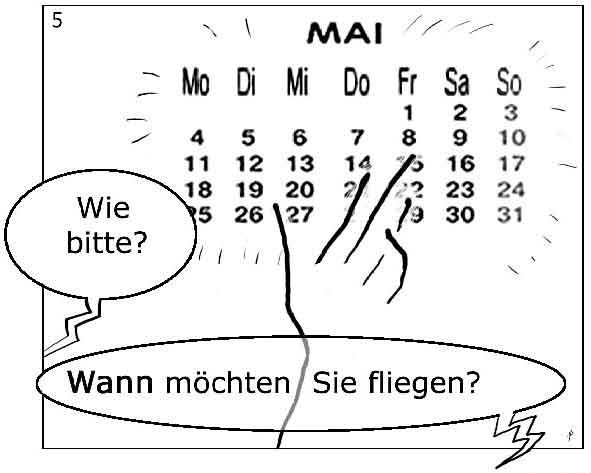
![]() · Wie bitte? – Wann möchten Sie fliegen?
· Wie bitte? – Wann möchten Sie fliegen?
![]() · ¿Perdón? – ¿Cuándo quiere (Ud.) volar?
· ¿Perdón? – ¿Cuándo quiere (Ud.) volar?
![]() · Pardon? – When do you want to fly?
· Pardon? – When do you want to fly?
![]() · Pardon? – Quand voulez-vous voler ?
· Pardon? – Quand voulez-vous voler ?
Bild 6 & Audio 6
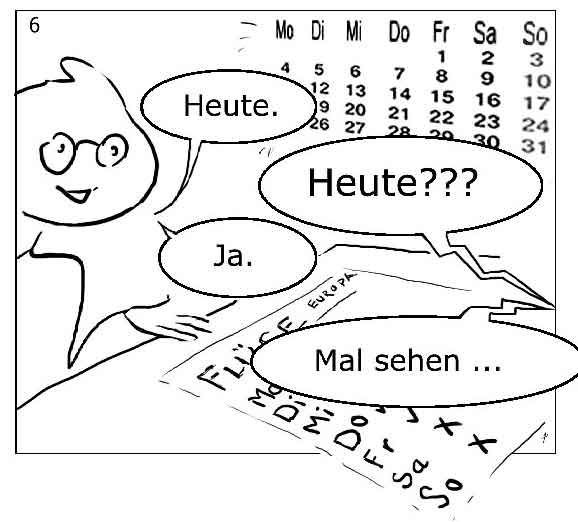
![]() · Heute. – Heute???? – Ja. – Mal sehen…
· Heute. – Heute???? – Ja. – Mal sehen…
![]() · Hoy. – ¿¿Hoy?? – Sí. – A ver ….
· Hoy. – ¿¿Hoy?? – Sí. – A ver ….
![]() · Today. – Today??? – Yes. – Let’s see….
· Today. – Today??? – Yes. – Let’s see….
![]() · Aujourd’hui. – Aujourd’hui??? – Oui. – Voyons….
· Aujourd’hui. – Aujourd’hui??? – Oui. – Voyons….
Arbeitsblatt 1 · Ficha de trabajo 1
Worksheet 1 · Feuille de travail 1
![]() · Nimm das Arbeitsblatt 1, erinner das Gehörte und wiederhol die Dialoge aus dem Gedächtnis
· Nimm das Arbeitsblatt 1, erinner das Gehörte und wiederhol die Dialoge aus dem Gedächtnis
![]() · Utiliza la ficha de trabajo 1, recuerda el audio y repite los diálogos, de memoria
· Utiliza la ficha de trabajo 1, recuerda el audio y repite los diálogos, de memoria
![]() · Take the worksheet 1, remember the audio and repeat the dialogs, by heart
· Take the worksheet 1, remember the audio and repeat the dialogs, by heart
![]() · Utilise la feuille de travail 1, fais mémoire et répète les dialogues, par coeur
· Utilise la feuille de travail 1, fais mémoire et répète les dialogues, par coeur
Arbeitsblatt 2 · Ficha de trabajo 2
Worksheet 2 · Feuille de travail 2
![]() · Nimm das Arbeitsblatt 2, erinner das Gehörte und wiederhol die Dialoge aus dem Gedächtnis. Variiere das Reiseziel.
· Nimm das Arbeitsblatt 2, erinner das Gehörte und wiederhol die Dialoge aus dem Gedächtnis. Variiere das Reiseziel.
![]() · Utiliza la ficha de trabajo 2 para repetir los diálogos de memoria, variando el destino del viaje
· Utiliza la ficha de trabajo 2 para repetir los diálogos de memoria, variando el destino del viaje
![]() · Use the worksheet 2 to repeat the dialogs by heart, introducing variations for the destiny
· Use the worksheet 2 to repeat the dialogs by heart, introducing variations for the destiny
![]() · Utilise la feuille de travail 2 pour répéter par coeur les dialogues, variant le destin du voyage
· Utilise la feuille de travail 2 pour répéter par coeur les dialogues, variant le destin du voyage
Variationen:
![]() Ergänze Ja, Nein oder nicht. Hör dann das Audio.
Ergänze Ja, Nein oder nicht. Hör dann das Audio.
![]() Completa con Ja, Nein o nicht. Luego comprueba escuchando el audio.
Completa con Ja, Nein o nicht. Luego comprueba escuchando el audio.
![]() Complete with Ja, Nein or nicht. Then listen the audio.
Complete with Ja, Nein or nicht. Then listen the audio.
![]() Complète avec Ja, Nein ou nicht. Après vérifie en écoutant l’enregistrement audio.
Complète avec Ja, Nein ou nicht. Après vérifie en écoutant l’enregistrement audio.
Ja – nein – nicht
Deutschland ist in Amerika? – Nein. Deutschland ist nicht in Amerika!
Senegal ist in Afrika? – _Ja_ . Senegal ist in Afrika!
 Kanada ist in Europa? – ____. Kanada ist _____ in Europa!
Kanada ist in Europa? – ____. Kanada ist _____ in Europa!
England ist in Australien? – ____. England ist ____ in Australien!
Spanien ist in Asien? – ____. Spanien ist ____ in Asien!
Paris ist in Europa? – ____. Paris ist in Europa.
Paris ist in Deutschland? – ____! Paris ist _____ in Deutschland.
Berlin ist ein Land? – ____ , Berlin ist eine Stadt in Deutschland.
Möchten Sie einen Flug nach Deutschland? – ____, bitte! Nach Berlin.
Wann möchten Sie fliegen? Heute? – _____ danke. Heute ______!
Möchten Sie ein Hotel in Frankfurt? – Nein, _____ in Frankfurt! In Berlin!
Ja, bitte. – Nein, danke.
![]() Ja, bitte! – Nein, danke.
Ja, bitte! – Nein, danke.
Bitte und Danke benutzt man STÄNDIG auf Deutsch!
„Bitte“ als Reaktion auf „Danke“ bedeutet „gern geschehen“.
![]() Sí, por favor. – No, gracias.
Sí, por favor. – No, gracias.
Bitte y Danke se usan PROFUSAMENTE en alemán!
„Bitte“ como reacción después de „Danke“ significa „De nada“.
![]() Yes, please. – No, thank you.
Yes, please. – No, thank you.
Bitte and Danke are used CONTINUALLY in German!
„Bitte“ used as reaction to „Danke“ means „You’re welcome“.
![]() Oui, s’il vous plaît – Non merci.
Oui, s’il vous plaît – Non merci.
Bitte et Danke s’utilisent CONSTAMMENT en allemand!
„Bitte“ est aussi la réaction à „Danke“. Dans ce cas, „Bitte“ signifie „je vous en prie / de rien“.
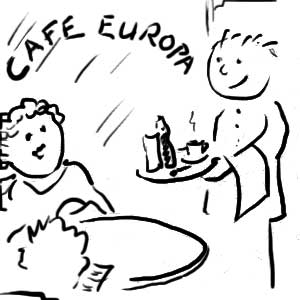 Möchten Sie eine Coca Cola ? – Ja, bitte!
Möchten Sie eine Coca Cola ? – Ja, bitte!
Und Sie? Möchten Sie ein Bier? – Nein, danke.
Was möchten Sie denn? – Kaffee, bitte.
…
Hier, bitte! Eine Coca Cola und ein Kaffee.
Oh, danke! – Danke!
Bitte.
Spiel den Dialog · Juega la escena del diálogo · Play the dialogue · Joue la scène
Gratis-Deutschkurs WELT-REISEN
Curso de Alemán audiovisual
· aprende alemán con cómics·
WELT-REISEN
Cours d’allemand audiovisuel en bande dessinée
Audiovisual German Course
· Learn German with Comics·
>>> Lektion 3 >>> Lección 3 >>> Lection 3 >>>
Sprachliche Situationen:
– Information verstehen und erfragen: Wochentage, Preis, wann?, wie bitte?
– Wunsch ausdrücken: ich möchte…, bitte?
– Personen identifizieren: Name, Wie heißen Sie?, Ich heiße…
– Basis-Konjugation
– nach Eigenschaften fragen: wie?
– Grammatik: das Substantiv
– Zahlen,…
Instruktionen · Instructions
 Wie lerne ich mit dem Comic?
Wie lerne ich mit dem Comic?
 ¿Cómo estudio con el cómic?
¿Cómo estudio con el cómic?
 How to learn with the comic?
How to learn with the comic?
 Comment apprendre avec la bande dessinée?
Comment apprendre avec la bande dessinée?
1)
![]() · Betrachte die Bilder und situiere den Kontext der Geschichte
· Betrachte die Bilder und situiere den Kontext der Geschichte
![]() · Mira las imágenes y sitúa el contexto de la historieta
· Mira las imágenes y sitúa el contexto de la historieta
![]() · Look at the illustrations and situate the story’s context
· Look at the illustrations and situate the story’s context
![]() · Regarde les images et situe le contexte de l’histoire
· Regarde les images et situe le contexte de l’histoire
2)
![]() · Hör das Audio und identifiziere die einzelnen Szenen
· Hör das Audio und identifiziere die einzelnen Szenen
![]() · Escucha el audio e identifica las diferentes escenas
· Escucha el audio e identifica las diferentes escenas
![]() · Listen the audio and identify each scene
· Listen the audio and identify each scene
![]() · Écoute le fichier audio et identifie chaque scène
· Écoute le fichier audio et identifie chaque scène
3)
![]() · Versetze dich in die Situation und versuche, den Dialog zu verstehen
· Versetze dich in die Situation und versuche, den Dialog zu verstehen
![]() · Métete en la situación e intenta comprender el diálogo
· Métete en la situación e intenta comprender el diálogo
![]() · Imagine yourself in the situation and try to understand the dialogue
· Imagine yourself in the situation and try to understand the dialogue
![]() · Mets-toi dans la situation et essaie de comprendre le dialogue
· Mets-toi dans la situation et essaie de comprendre le dialogue
4)
![]() · Höre das Audio viele Male und wiederhole, was du hörst (das Geschriebene täuscht!!!!)
· Höre das Audio viele Male und wiederhole, was du hörst (das Geschriebene täuscht!!!!)
![]() · Escucha el audio repetidas veces e imita lo que oyes (¡¡¡no te guíes por la ortografía!!!)
· Escucha el audio repetidas veces e imita lo que oyes (¡¡¡no te guíes por la ortografía!!!)
![]() · Listen the audio repeatedly and imitate what you hear (don’t be misled by the orthography!!!)
· Listen the audio repeatedly and imitate what you hear (don’t be misled by the orthography!!!)
![]() · Écoute le fichier audio plusieurs fois et répète ce que tu entends dire (ne te laisse pas tromper par l’orthographe!!!)
· Écoute le fichier audio plusieurs fois et répète ce que tu entends dire (ne te laisse pas tromper par l’orthographe!!!)
5)
![]() · Lies die Erklärungen zu den Einzelbildern und überprüfe dein Textverständnis
· Lies die Erklärungen zu den Einzelbildern und überprüfe dein Textverständnis
![]() · Repasa las viñetas individuales y comprueba si has comprendido bien los textos
· Repasa las viñetas individuales y comprueba si has comprendido bien los textos
![]() · Review the successive images and check your text comprehension
· Review the successive images and check your text comprehension
![]() · Repasse les vignettes individuelles et vérifie si tu as bien compris les textes
· Repasse les vignettes individuelles et vérifie si tu as bien compris les textes
6)
![]() · Nimm das Arbeitsblatt ohne Text und wiederhol die Dialoge aus dem Gedächtnis
· Nimm das Arbeitsblatt ohne Text und wiederhol die Dialoge aus dem Gedächtnis
![]() · Utiliza la ficha de trabajo sin texto y repite los diálogos, de memoria
· Utiliza la ficha de trabajo sin texto y repite los diálogos, de memoria
![]() · Take the worksheet without text and repeat the dialogs, by heart
· Take the worksheet without text and repeat the dialogs, by heart
![]() · Utilise la feuille de travail sans texte et répète les dialogues, par coeur
· Utilise la feuille de travail sans texte et répète les dialogues, par coeur
7)
![]() · Spiel(t) den Dialog frei nach, später mit Reisezielvarianten
· Spiel(t) den Dialog frei nach, später mit Reisezielvarianten
![]() · Representa(d) el diálogo de memoria, variando luego el destino del viaje
· Representa(d) el diálogo de memoria, variando luego el destino del viaje
![]() · Enact the dialogue, unguided, and later introducing variations of the destiny
· Enact the dialogue, unguided, and later introducing variations of the destiny
![]() · Joue(z) le dialogue sans repère, variant aussi la destination du voyage
· Joue(z) le dialogue sans repère, variant aussi la destination du voyage
8)
![]() · Du verstehst ein Wort nicht? Schau nach im Wörterbuch von WELT-REISEN
· Du verstehst ein Wort nicht? Schau nach im Wörterbuch von WELT-REISEN
![]() · En caso de duda, consulta el diccionario de WELT-REISEN
· En caso de duda, consulta el diccionario de WELT-REISEN
![]() · En case of doubt about the vacabulary, consult the WELT-REISEN dictionary
· En case of doubt about the vacabulary, consult the WELT-REISEN dictionary
![]() · En cas de doute, consulte le dictionnaire de WELT-REISEN
· En cas de doute, consulte le dictionnaire de WELT-REISEN
Gratis-Deutschkurs WELT-REISEN
Index · Índice
- Gratis-Deutschkurs WELT-REISEN · Lektionen-Index
- WELT-REISEN 1 · Gratis-Deutschkurs · audiovisuell Deutschlernen mit COMICs ·
Lektion 1: Im Reisebüro WELT-REISEN - WELT-REISEN 2 · audiovisueller COMIC zum Deutschlernen ·
Lektion 2: Im Reisebüro WELT-REISEN - WELT-REISEN 3 · audiovisueller Deutschkurs · Gratis · Deutsch lernen mit COMICs
Lektion 3: Im Reisebüro WELT-REISEN · eine Reise buchen - Präsens-Konjugation von HABEN und SEIN · Beispiele, Audio mp3+Transkription
- WELT-REISEN – Wörterbuch · Diccionario · Dictionary · Dictionnaire · ONLINE
- Unregelmäßige Verbformen im Deutschen – Liste mit Schnell-Suchfunktion
- WELT-REISEN · Die Zahlen von 0 bis 1000 · Audio mp3 + interaktive Übungen
- Die Uhrzeit auf Deutsch, formell und umgangssprachlich
Erklärung und interaktive Übungen A1/A2 - WELT-REISEN · Wie lerne ich Deutsch mit dem DaF-Comic-Anfängerkurs?
- Die trennbaren Verben im Deutschen: eine interaktive Schnelleinführung

